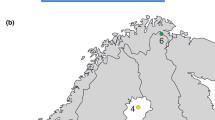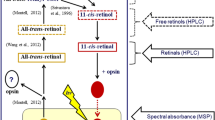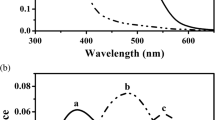Abstract
-
1.
Relative retinal amounts in the compound eye of the Antarctic amphipod Orchomene plebs were assessed during conditions of continuous summer daylight every 3 h over a period of 48 h. The habitat of the experimental animal is the bottom of the Ross Sea (78°S; 166°E) down to depths of at least 400 m; water temperature is a constant — 1.8° C. A periodicity of 12 h was detected with relative amounts of 11-cis retinal exhibiting peaks at midday and at midnight and troughs at 7.00 h and 19.00 h.
-
2.
The result that 90% of retinoid were insoluble in n-hexane suggests that at least 90% of the measured retinoid were attached to membrane-bound proteins such as opsin.
-
3.
Selective light adaptation showed that the visual pigments were thermostable and photoregenerable. The main absorbance peak of rhodopsin, compared with metarhodopsin, seems to be in the longer wavelengths.
Similar content being viewed by others
References
Aréchiga H, Wiersma CAC (1969) Circadian rhythm in the responsiveness of visual units in the crayfish. J Neurobiol 1:71–85
Barrell GK, Montgomery GW (1989) Absence of circadian patterns of secretion of melatonin or Cortisol in Weddell seals under continuous natural daylight. J Endocrinol 122:445–449
Bliss VL, Heppner FP (1976) Circadian activity rhythm influenced by near zero magnetic field. Nature 261:411–412
Brown PK, Brown PS (1958) Visual pigments of the Octopus and cuttlefish. Nature 182:1288–1290
Bünning E (1973) The physiological clock: circadian rhythms and biological chronometry. Springer, Berlin Heidelberg New York
Eakin RM (1972) Structure of invertebrate photoreceptors. In: Dartnall HJA (ed) Handbook of sensory physiology Vol VII/1. Springer, Berlin Heidelberg New York, pp 625–684
Edmunds LN (1988) Cellular and molecular basis of biological clocks. Springer, Berlin Heidelberg New York
Hariyama T, Tsukahara Y (1992) Endogenous rhythms in the amounts of 11-cis retinal in the compound eye of Ligia exotica (Crustacea, Isopoda). J Exp Biol 167:39–46
Hariyama T, Meyer-Rochow VB, Eguchi E (1986) Diurnal changes in ultrastructure and function of the compound eye of Ligia exotica (Crustacea, Isopoda). J Exp Biol 123:1–26
Hempel G, Hempel I (1959) Über die tägliche Verteilung der Laufaktivität bei Käfern des Hohen Nordens. Naturwissenschaften 42:77–78
Hubbard R, StGeorge RCC (1958) The rhodopsin system of the squid. J Gen Physiol 41:501–528
Isono K, Hariyama T, Kito Y, Tsukahara Y (1986) Exogenous and diurnal rhythms of chromophore turnover of visual pigment in the locust eye as analyzed by HPLC. Neurosci Res (Suppl) 4:1–10
Johnson A, Engelmann W, Klemke W, Ekse AT (1979) Freerunning circadian rhythms in Svalbard. Z Naturforsch 34c: 470–473
Jones DA, Hobbins CSC (1985) The role of biological rhythms in some sand beach cirolanid Isopoda. J Exp Mar Biol Ecol 93:47–59
Littlepage JL (1965) Oceanographic investigations in McMurdo Sound, Antarctica. Biol Antarctic Seas 2 (Antarctic Res Ser 5):1–37
Lobban ML (1967) Daily rhythms of renal excretion in Arcticdwelling Indians and Eskimos. Quart J Exp Physiol 52:401–410
Massom RA (1988) The biological significance of open water within the sea-ice covers of the polar regions. Endeavour 12:21–28
Meyer-Rochow VB (1975) Larval and adult eyes of the Western rock lobster (Panulirus longipes). Cell Tissue Res 162:439–457
Meyer-Rochow VB (1985) A study of unusual intracellular organelles and ultrastructural organization of the eye of Gammarus oceanicus fixed in the midnight sun of the Spitzbergen (Svalbard) summer. Biomed J 6:353–367
Meyer-Rochow VB, Suzuki T (1986) A study of visual pigments in the two Antarctic crustaceans Orchomene plebs (Amphipoda) and Glyptonotus antarcticus (Isopoda). Comp Biochem Physiol 83B: 75–78
Meyer-Rochow VB, Tiang KM (1979) The effects of light and temperature on the structural organization of the eye of the Antarctic amphipod Orchomene plebs (Crustacea). Proc R Soc Lond B 206:353–368
Mitsui A, Kumazawa S, Takahashi A, Ikemoto H, Cao S, Arai T (1986) Strategy by which nitrogen-fixing unicellular Cyanobacteria grow photoautotrophically. Nature 323:720–722
Morgan E (1991) An appraisal of tidal activity rhythms. Chronobiol Internat 8:283–306
Peiponen VA (1962) Arch Soc Zool Fennica “Vanamo” 17:171–178 (cited in Bünning 1973)
Suzuki T, Makino-Tasaka M (1983) Analysis of retinal and 3-de-hydroretinal in the retina by high pressure liquid chromatography. Anal Biochem 129:111–119
Welsh JH (1930) Diurnal rhythm of distal pigment cells in the eyes of certain crustaceans. Proc Natl Acad Sci USA 16:386–395
Williams BG, Naylor E (1967) Spontaneously induced rhythm of tidal periodicity in laboratory-reared Carcinus. J Exp Biol 47:229–234
Yeates NW (1971) Diurnal activity in the Adelie penguin (Pygoscelis adeliae) at Cape Royds, Antarctica. J Nat Hist 5:103–112
Zeiger J, Goldsmith TH (1989) Spectral properties of porphyropsin from an invertebrate. Vision Res 29:519–527
Author information
Authors and Affiliations
Rights and permissions
About this article
Cite this article
Hariyama, T., Terakita, A. & Meyer-Rochow, V.B. Rhythmicity of chromophore turnover of visual pigment in the Antarctic amphipod Orchomene plebs (Crustacea; Amphipoda). J Comp Physiol A 173, 615–619 (1993). https://doi.org/10.1007/BF00197769
Accepted:
Issue Date:
DOI: https://doi.org/10.1007/BF00197769




